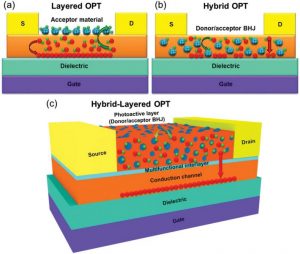Organic phototransistors (OPTs) are widely used in environmental as well as health monitoring, quantum communication, chemical and biomedical sensing, remote control, surveillance, and image sensors. They are outstanding for their low-cost, light-weight, high efficiency, and environmental friendliness.
The interfacial charge effect is crucial for high-sensitivity OPTs. Conventional layered and hybrid OPTs suffer from the trade-off in well balancing the separation, transport, and recombination of photogenerated charges.
Organic phototransistors are the research field of Xinwei Wang and Li Jia from the Chinese Academy of Sciences. Now they developed a novel hybrid-layered architecture to improve the overall photodetection performance of OPTs by simultaneously taking advantages of charge-trapping effects and efficient carrier transport.
The structure of the novel hybrid-layered phototransistor (HL-OPT) consists of a high mobility organic semiconductor channel layer for fast carrier transport, an organic bulk heterojunction (BHJ) photoactive layer, and an ultrathin inorganic interlayer sandwiched inbetween.
As a result, by combining the virtues of charge-trapping effects and fast carrier transport, significant enhancement in the overall photodetection performance is achieved from the HL-OPT.
To evaluate potential applications of the high-performance HL-OPT, the researchers fabricated the devices on flexible substrates and confirmed their excellent flexibility.
Meanwhile, the devices were also integrated into a one-dimensional array and demonstrated the reliability of the HL-OPT in photosensitive imaging system.
“These successful trials make the HL-OPT particularly appealing for the applications in flexible and wearable optoelectronic devices.” said Prof. Jia.
This work provides new insights into the design and optimization of high-performance photodetectors, spanning the ultraviolet and near infrared range, and suggests the fundamental issues pertaining to electronic and photonic properties of the devices.
“Another exciting point is that this organic photodetector can be potentially fabricated by using printing techniques, which would further reduce the process cost,” said Jia. “I hope this work can provide the market with a promising solution for photodetectors by combining both high performance and low cost.”

Schematic of the different OPTs.

















